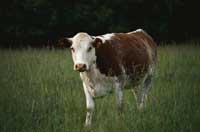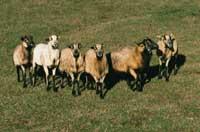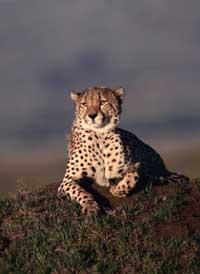Other spontaneous encephalopathies

The new variant of Creutzfeldt-Jakob syndrome in humans for eating sick cow meat and bovine spongiform encephalopathy have been known today, but human spongiform encephalopathies have been "natural". They are known since the early twentieth century. A brief review was published in issue 161 of the magazine Elhuyar Zientzia eta Teknika (January 2001), in the article "Mad Cows, sample of the madness of the human being".
More known spontaneous encephalopathies
With the exception of scrapie, the rest of spontaneous encephalopathies affecting several animal species are less known. All damage the nervous system, no remedies are known and the origin is sometimes unknown. They are transmitted by prions and the transmission can be horizontal (from animal to neighboring animal) or vertical (from mother to baby).
In bovine spongiform encephalopathy, it is considered that the transmission is horizontal, that is, they receive prions through feed, which are the causes of the disease. For this reason, by prohibiting feed made with meat flours, it is expected to end the disease. However, if there was a vertical transmission, the disease would pass from generation to generation and end the disease would be much more difficult. According to recent studies, in some cases it seems that it has been transmitted directly from the cow to the calf, but to ensure it more studies have to be done.
In addition, there are genetic factors to take into account. For example, in the new variant of human Creutzfeldt-Jakob syndrome, some have seen a natural tendency to become ill. All deaths from this disease had the same genetic characteristic (in the 129 elbow of the common prionic protein gene had homozygous genotype methionine).

In sheep and goats scrapie, genetics are also very influential. Within an autosomal recessive gene (SIP gene), the incubation period may be shorter or longer. In some animals this incubation period can be so long that they do not develop the disease throughout their lifetime. To combat scrapie, several veterinarians have proposed sheep farming with a long incubation period instead of sheep of easy development. However, this system can be very dangerous, since it does not make the disease disappear, but it hides it, because in addition the routes of transmission of the scrapie are both horizontal and vertical.
For all this, although there are still many similarities between scrapie and bovine spongiform encephalopathy, there are also differences. For example, scrapie XVIII. In the eighteenth century it was known and the disease of cows did not appear until 1985. On the other hand, it has never been shown that scrapie can be transmitted to humans and is not believed to have to do with genetics in bovine spongiform encephalopathy. In addition, in the disease of sheep and goats there are 20 strains of prions and only one in cows is known.
Also in cats

In addition to scrapie and bovine spongiform encephalopathy, the disease of this type that is most appearing in animals is Feline Spongiform Encephalopathy. Lately, cases have been published in the press, such as the appearance of a disease that caused the death of a cheetah, born in a French zoo. The food of this cheetah, of British father and mother of the South African Republic, was 40% chicken and rabbit and the other 60% beef seized or not marketed in slaughterhouses.
However, Feline Spongiform Encephalopathy has been known since 1990. It was first detected in a British domestic cat and in two years 24 cases occurred. In addition, the cases of these cats and cows appeared in the same regions. According to this, it seems that the origin of the disease is the same in both species, that is, the contaminated feeds made with meat flours would be those that extended it.
On the other hand, the symptoms of Spongiform Encephalopathy Felina are similar to other spontaneous encephalopathies, and the first change perceived by the owners occurs in the behavior of cats, which become aggressive and unreliable. Then they have problems of coordination and movement. The similarity with the variant of the disease that affects humans makes cats can be used as models to predict what can happen in humans. The disease appears much earlier in cats, because their life expectancy is shorter.
Subsequently, in addition to domestic cats, the disease has appeared in other cats, such as pepards or zoo tigers. But they are not the only damaged animals of the zoolocut, since it has been seen in the ungulates. In wild ungulates of natural and zoological parks the disease appears before, when animals are young, and development is much faster than in cows. In some cases, animals have died a few days after the first symptoms.
Apparently, the feed made with scrapie beef remains are those that have generated Visons Spongiform Encephalopathy. In the visons of nurseries a rapid extension of the disease occurs, since cannibalism among them is common. However, nothing more to see what happened, measures were taken and it was enough to give controlled feeds to end the disease.
Finally, there is another spongiform encephalopathy that appears in animals and was seen in two species of ungulates from the natural parks of Colorado and Wyoming. The first case, which appeared in 1967, has also been seen in animals living in the wild since then, but they do not know their origin.
Much research has yet to be done to unravel the origin and transmission of spontaneous encephalopathies, as well as the most effective prevention pathways. The transmission mechanism between species is also being investigated, while others are looking for ways for lesions (prionic plates) to be reversible. The results of all these studies, together with the generation of new questions, are expected to respond to others.
Buletina
Bidali zure helbide elektronikoa eta jaso asteroko buletina zure sarrera-ontzian











